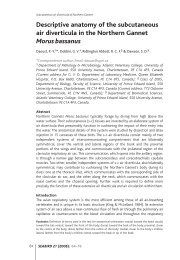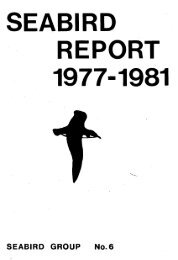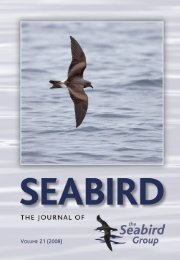You also want an ePaper? Increase the reach of your titles
YUMPU automatically turns print PDFs into web optimized ePapers that Google loves.
212 T. KRÜGER & S. GARTHE Atlantic <strong>Seabird</strong>s 3(4)<br />
Black-throated Divers Parelduikers (Frits-Jan Maas)<br />
DISCUSSION<br />
According to Bruderer (1971), migration altitude is influenced – always within<br />
the limits set by the aerodynamic and physiological characteristics of the species<br />
– by secondary (external) factors, principally meteorological factors such as<br />
wind, fog, cloud conditions and precipitation, and changes in overall weather<br />
conditions. Among these, wind is of greatest importance (Alerstam 1979a). <strong>The</strong><br />
horizontal speed of wind over the sea increases with height; directly above the<br />
water surface there is a zone of lower wind speed caused by the breaking effect<br />
of the water. Jameson (1960) describes a case where the wind speed just 15 m<br />
above sea level was at force 8 Bft, twice that immediately above the water<br />
surface. Wind reaches its full force only above 500 m (Alerstam 1979b;<br />
Nachtigall 1987; Stein & Schultz 1995).<br />
Assuming that the radar ornithological results apply, the observations<br />
of the present study confirm those of numerous investigations showing that the<br />
height of migration in tail wind conditions is greater than that in headwinds, and<br />
that where wind direction is opposed to the migration direction, in general lower








